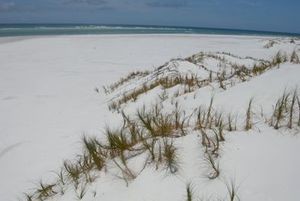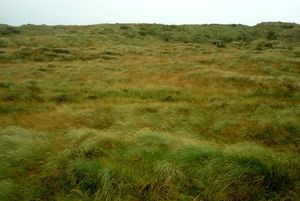 Coastal dunes dominated by pingao at Parengarenga Harbour, Northland. (Photo: John Sawyer)Coastal dunes are commonly found immediately landward of a beach and are made up of large, linear accumulations of sand. These form as wind carries sand and sediments from the beach in a landward direction, depositing it wherever an obstruction prevents it going further. Coastal foredunes are the most dynamic part of a dune system. They occupy the drier raised coastal sand and gravels seaward of the coastal forest zone. Dry beach sand is moved inland by wind and trapped by dunes and their plants. Sand dunes form in coastal areas where there is shelter from strong waves, a good supply of sand, onshore winds, and dune-binding plants such as grasses and sedges.
Coastal dunes dominated by pingao at Parengarenga Harbour, Northland. (Photo: John Sawyer)Coastal dunes are commonly found immediately landward of a beach and are made up of large, linear accumulations of sand. These form as wind carries sand and sediments from the beach in a landward direction, depositing it wherever an obstruction prevents it going further. Coastal foredunes are the most dynamic part of a dune system. They occupy the drier raised coastal sand and gravels seaward of the coastal forest zone. Dry beach sand is moved inland by wind and trapped by dunes and their plants. Sand dunes form in coastal areas where there is shelter from strong waves, a good supply of sand, onshore winds, and dune-binding plants such as grasses and sedges.
 Dune system dominated by marram and exotic grass species, Fortrose, Southland (photo: Jesse Bythell).In New Zealand the two main native species of ‘sand-binders’ are the endemic sedge pingao, and the silvery sand grass or spinifex. Other native plants in dunes are sand tussock, sand coprosma and sand daphne. A common introduced sand-binding plant is marram grass that has taken over considerable expanses of New Zealand’s dune landscape.
Dune system dominated by marram and exotic grass species, Fortrose, Southland (photo: Jesse Bythell).In New Zealand the two main native species of ‘sand-binders’ are the endemic sedge pingao, and the silvery sand grass or spinifex. Other native plants in dunes are sand tussock, sand coprosma and sand daphne. A common introduced sand-binding plant is marram grass that has taken over considerable expanses of New Zealand’s dune landscape.
Sand dunes may also form in arid and semi-arid regions or where there is considerable accumulation of sand.
For more information about coastal dunes see:
- Our own gold coast(information about NZ dunes) (DOC website)
- Coastal foredunes in Wellington Conservancy (DOC publication)
- Coastal foredunes factsheet (DOC)
- Coastal Restoration Trust of New Zealand
- Sand dunes (The Geography Site - UK)
- Dunes and beaches (Seafriends NZ website)
